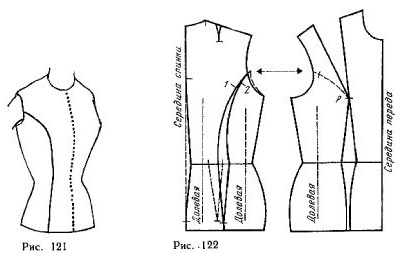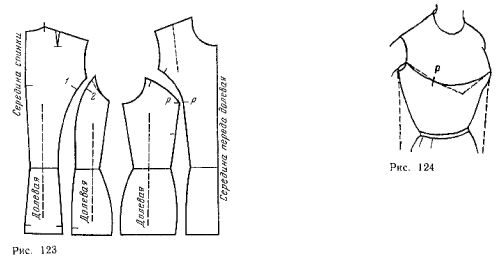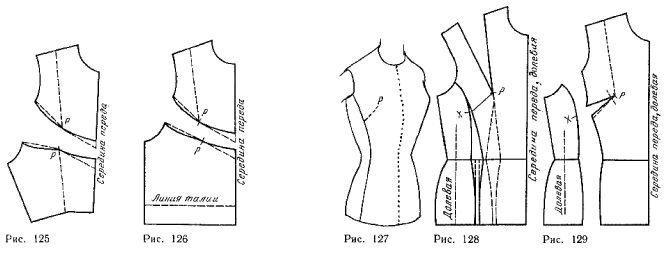
Form of relief depends not only on model but also on the shape. Some pieces need more sharply to round a line from the point R to the armhole, others must bring this line to the shoulder cut.
Across the line of the terrain at a distance of 3-4 cm from the line of openings make nadziejko (figure 122). Approximately midway between the side lines of the cut and relief indicate the direction of grain lines parallel to the line of mid front. Put on a sheet of paper separately both parts of the patterns previously transferred tuck in the top line of the relief.
Put on a sheet of paper back basic patterns, a tuck at the waist line mark just below the waist line dashed lines. At a distance of one third of the value of the solution of the tuck from the middle of the back draw a new line the middle of the back. The remaining two-thirds of the value of the solution was spread on either side of the second line of the tuck Foundation. Through the obtained points, swipe down on the waist line of the new dart. The mid-line of the tucks should be parallel to the line of the middle of the back.
When you build a line of relief from the line of openings it is necessary to remember that the line of the front elevation must not be above the elevation of the back. To find the point of elevation of the line of openings put in front and back, next, equating the bottom of the openings, and slide the horizontal, as shown in figure 122, the dashed line arrow. Starting from the point on the line of guide openings, a smooth curve into a tuck at the waist line.
The line of elevation of the backrest at a distance of 3-4 cm from the line of openings make nadziejko 1 to the left of the line.
Measure the first line of relief from notch 1 to the waist line. Starting from the waist line, put up the obtained value in the second line of the relief and make nadziejko 2, which will be higher than the first, due to the different curvature of contour lines. When connecting both parts of the waist of notch 1 and 2 can be combined, but broken line of the armhole. In order to level up, need a second line of relief to continue on the remaining length (the distance between nasecki 1 and 2). Check with the line of openings, as shown in figure 123.

Specify the direction of the grain lines on both parts of the back.
Models with the reliefs from the armhole and shoulder cut are classic, and the relief from the shoulder cut visually lengthens the figure. It can be recommended to full women. For the production of striped fabrics, a cage or with a strong thread of this relief is not appropriate, as the offset of the filaments caused by tuck, more markedly than in the relief sent from the line of openings.
Figure 124 presents two reliefs: the dashed line shows the topography consisting of tuck from the line of openings and Darts from the middle of the front (see figure 98); the solid line shows a rounded elevation passing through the point R. Both terrain gives almost the same view of the model, but in a completely different run.
Put on a sheet of paper in front of bodice basic patterns and draw a line of a rounded relief. Transfer onto a single sheet of paper both common and patterns ( Fig . 125). No matter how you ran the pattern ( by cutting patterns, or by transfer through the transparent paper), both lines of the middle of the front must be on the same line, as in this example.

Figure 126 shows the same rounded elevation model straight silhouette. When comparing figure 125 and 126 show that the line of elevation of the upper part of the same, and the bottom is different, which is caused by the lack of Darts at the waist on one of them.
Figure 127 shows the model with relief, which takes place at some distance from the point P, and therefore cannot translate the upper tuck. In this case, the tuck is better positioned so that it is less distorted external view of the model.
In figure 127, the tuck indicated by the dashed line.
It can also translate into the neck, especially if the model with large collar and wide lapels that can hide the tuck.
Put in front of basic patterns, a dashed line denoting a tuck at the waist ( Fig . 128). Close the top tuck and place the mold on the figure. Draw the first line of relief from the armhole to the waist, following the direction of the Darts on the waist line. The most aesthetic terrain, passing at a distance of not less than 7 - 8 cm from point P (for products of medium size) .
If the model is adjacent silhouette in relief can translate part of the tuck at the waist line. If the model of direct silhouette, enough one line . From the first line of relief, put the value of the solution tucks at the waistline at the side cut (2-3 cm ).
Tuck translated into relief and, therefore, distant from the point P, does not provide a snug fit of the front of the product to the figure, so its not the whole solution was transferred to relief.
At the top of the bodice connect both lines of relief and continue their slightly convex line to the outlet of the openings. Below the waist line Darts in the middle, draw two parallel lines indicating the magnitude of the reduction solution Darts at the hips. Topography lines should touch these lines, as shown in figure 128. If the base curve is not marked is decreasing, i.e. if the tuck on the waist line goes down to the hip line, enough to hold of tuck end straight line down to mark the line of the terrain. On line relief mark nadziejko (with X mark) is the beginning of the upper tuck — and specify the direction of grain lines.
Translate this pattern into another sheet of paper, translating the upper dart in the indicated direction (Fig . 129). In case of unequal convexity of contour lines the distance from nasechek to the waist line will also vary, so you should reduce the first line of relief by increasing the solution top Darts (see the dashed line in figure 129). Close the tuck and correct the curvature of contour lines.



